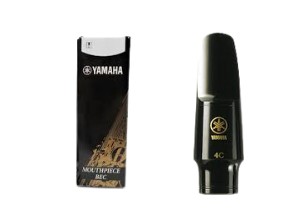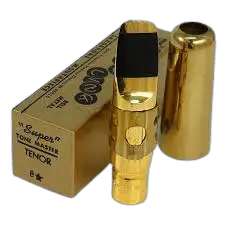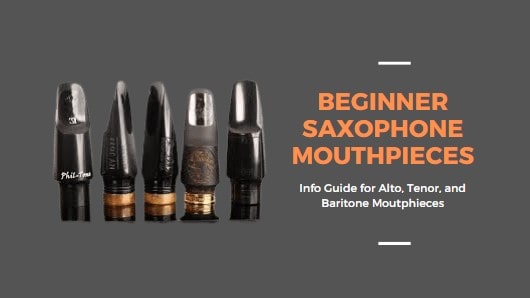No matter what your style, alto to soprano or bass, beginner to pro, or on a budget flush with cash, picking the right saxophone mouthpiece for your instrument is always important! As much important as deciding on your best choices for alto saxophones.
It makes a world of difference in the quality of the sound you produce, and the music your sax makes. However, with hundreds of options to choose from it’s not always easy to make the right choice.
In this guide we’ll be going over:
- the important parts of a saxophone mouthpiece
- the key differences in mouthpieces, particularly mouthpiece brands/styles and tip/facing sizes
- our recommendations for classical, jazz, and budget mouthpieces for Alto, Tenor, and Baritone.
What Is a Mouthpiece? And Why are There so Many Different Ones?
Typically for saxophones, mouthpieces work in conjunction with reeds to produce sound.
The type of sound produced varies depending both on the shape and make of both the mouthpiece and reed. Specifically for this guide, we’ll be focusing on the mouthpiece.
There are many parts to a mouthpiece, but the important pieces to focus on in terms of drastic sound quality changes are the tip opening, baffle, and chamber.
The following diagram will give you context to these terms as well as any other parts you may have questions about.

Classical and Jazz? What’s the Difference Regarding Sax Mouthpieces?
We are glad you asked!
Essentially, we think of Classical mouthpieces as having a more “pure” saxophone sound, and Jazz mouthpieces as having a more “dark and rich” sound.
If you’re performing in a classical ensemble, you want to try your best to blend with the rest of the band, and a jazz mouthpiece would make your tone “harsher” in this context.
Inversely, in a jazz ensemble (or rock/pop group) you are competing with many loud, and amplified instruments like guitar and keyboard. You need “thicker” tones to be heard, and you’d be “lost in the crowd” with a classical mouthpiece.
As a general rule of thumb, Classical mouthpieces have small/tight tip openings, relatively flat baffles, and small chambers.
In contrast, Jazz mouthpieces typically have wide tip openings, taller baffles, and bigger chambers. The following diagram will give you context to these terms as well as any other parts you may have questions about.
What Makes a Beginner Mouthpiece? And Should I Upgrade My Current One?
Most of the time a beginner mouthpiece is a cheap one. Not really that different when you purchase a student or beginner-level saxophone.
It’s designed similarly to a typical classical mouthpiece with a closed/tight tip opening to make producing a sound easier but usually designed with cheaper and less durable material and without the quality of sound in mind.
A beginner mouthpiece wants to help you produce a sound, instead of focusing on helping you produce a good sound.
As for upgrading, that is up to you!
If you’re getting to the point where you have the basics of your instrument down pretty well and you can start to focus on the tone of your instrument while still sticking to the basic form, it’s probably a good time to start looking for an upgraded sax mouthpiece.
So Which Saxophone Mouthpiece is Right for Me?
It all depends.
Personally, I love all things Vandoren. I use the Vandoren Java series mouthpiece as a generally well-rounded mouthpiece for both jazz and classical, alongside Vandoren and Vandoren Java Reeds size 3, and if that doesn’t get the job done, I use the Cannonball mouthpiece that came with my Cannonball key series tenor sax (a very short and thick mouthpiece, with a pretty big chamber) for more “jazzy endeavors”.
However, this by no means indicates it’s the right fit for your needs.
I typically play much more jazz than classical, and I would almost certainly want to invest in a more specialized mouthpiece for more classical pursuits.
And these mouthpieces also may be out of your price range. The Vandoren java series currently sits at a hefty $140, and the Cannonball saxophone I own that included my other mouthpiece came out to $2,500.
Recommended Saxophone Mouthpieces for Alto, Tenor and Baritone
Below we are going to provide some of our recommendations to various styles of mouthpieces for jazz and classical in various price ranges to suit your needs.
Vandoren Java Series
A pretty well-rounded choice, not the most expensive, but definitely not the cheapest.

Alto Mouthpiece
- Vandoren SM501B A35 JAVA
Tenor Mouthpiece
- Vandoren SM511B T45
Baritone Equivalent
- Vandoren SM434
Yamaha C Series
A simple but effective clean tone mouthpiece. One of the best budget options on the market.

Alto Mouthpiece
Tenor Mouthpiece
- Yamaha Tenor Saxophone Mouthpiece YACTS4C
Baritone Mouthpiece
- Yamaha Baritone Saxophone Mouthpiece YACBS5C
Selmer Concept Series
“The Gold Standard” when it comes to classical mouthpieces.

Alto Mouthpiece
- Selmer Concept Saxophone Alto
Tenor Mouthpiece
- Selmer Concept Saxophone Tenor
Baritone Equivalent
- Selmer Hard Rubber Baritone Saxophone
Otto Link Tone Master Series
A jazz staple, played by John Coltrane himself on his tenor sax.

Alto Mouthpiece
- Otto Link OLM402 6S Master Mouthpiece
Tenor Mouthpiece
- Selmer Hard Rubber Baritone Saxophone
Baritone Mouthpiece
- Otto Link OLM 405 6S Master Mouthpiece
So What Now?
You’ve got a lot of information in front of you. It can certainly be overwhelming.
However, everything here you can take with a grain of salt.
Sure you can buy expensive, extremely specialized mouthpieces for every situation, but at the end of the day what matters is what sounds good and is most comfortable to you!
All you need to do is find a mouthpiece that seems good for your price range and try it out yourself.
What Are the Best Saxophone Mouthpieces?
For alto, tenor, and baritone saxophones, we’ve identified the following series models that have the best options in the market: Vandoren Java Series, Yamaha C Series, Selmer Concept Series, and Otto Link Tone Master Series.
With those reputable brands and models, you will have plenty of options depending on your level and budget.
Do Saxophone Mouthpieces Make a Difference?
Mouthpieces combined with reeds, make a great difference in the quality of the sound you produce, and the music your sax makes. No matter what your style, level, or budget is, picking the right saxophone mouthpiece for your instrument is really important.
